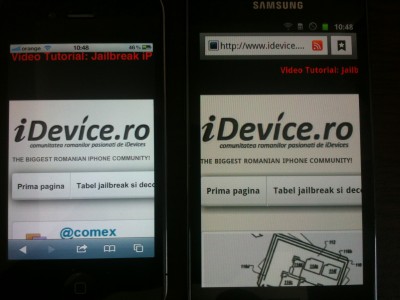With the help of those from Evomag I came into possession of one Samsung Galaxy S II, the best-selling Android smartphone at the moment, and for a week I will make some comparisons between the iPhone 4 and the terminal from Samsung. I start today with a comparison between the elements that we encounter the first time when we open any smartphone/mobile phone, the screens. The Samsung Galaxy S II has a 4.3-inch Super Amoled Plus screen with a resolution of 480×800 pixels and the iPhone 4 a Retina Display screen with a resolution of 960×640 pixels. Although we are not talking about a "Retina Display" screen, those from Samsung have devised a method to "fool" the human eye so that the number of subpixels perceived by us is 50% higher than in the case of the Samsung Galaxy S terminal, although in in reality the resolution remained the same.
Comparing Super AMOLED Plus with Retina Display you will find differences in terms of image clarity, but they are negligible and I am glad to see this. Practically, you will not see the pixels of the application icons as it happens on the iPad/iPad 2 tablet and you will see the writing of the web pages without having to zoom in beforehand, but here everything is related to the website. Although we are talking about a 0.8 inch larger screen, the clarity is similar to that of Retina Display screens and I say "similar" because if you bring the screen very close to your eye you will notice the differences between the clarity of icons and graphic elements. In conclusion, for the normal user the difference between the clarity of the Super AMOLED Plus and Retina Display screens is noticeable, but it all depends on the applications you use.
Unfortunately, the Samsung Galaxy S II screen has some small problems. The brightness is not great, even with maximum brightness the iPhone 4 screen does better in this regard and if you go out with the terminals out you will notice that on the iPhone 4 the images are slightly clearer but the difference is not great. Another very important problem lies in the quality of the colors displayed on the screen. No matter what applications I used, the Samsung Galaxy S II screen displayed more faded, darker images than the iPhone 4. I disabled the automatic brightness setting, chose the standard profile, and still the quality left much to be desired. Following the same idea, I opened 2 videos on YouTube and noticed with displeasure that on the Samsung Galaxy S II the images have a slight blue tinge. I read about this problem on many websites, I understood that some terminals brought to Romania display yellow colors, so it is a production problem and a very disturbing one.
Now let's move on to the big question: how usable is a 4.3 inch screen on a smartphone? Theoretically, a larger screen should offer the possibility to see more content and in better quality, right? Well no, this thinking is wrong because a 4.3 inch screen with a resolution of 480×800 will display less content on the screen than an iPhone 4. The screen is bigger, you see everything bigger but the lower resolution determines the Samsung Galaxy S II - to not display the entire format of a website, for example. The iPhone 4 displays everything, the Samsung Galaxy S II does not display a portion of the side of certain sites and all because of the lower resolution. For viewing content thanks to the media, things change because the Samsung Galaxy S II displays everything in a larger format and much more pleasant to view than the iPhone 4. Now to answer the question, a 4.3-inch screen is difficult to use with one hand, a 4.3-inch screen is made for people with large palms and long fingers, and an iPhone fits perfectly in your palm. Maybe 4 inches is the perfect size, but 4.3 inches is way too much from my point of view.
Now let's talk about the touchscreen. Because I think that the SGS II has a touchscreen that does not respond well to commands, I have news, it works just as well as the touchscreen in the iPhone. The orders are taken as quickly and well as in the case of an iPhone, so from this point of view I have nothing to complain about and I'm glad to see that the manufacturers are finally starting to catch up with the quality of the technologies used by Apple.
In the end, Gorilla Glass is not really that resistant and the problems regarding the quality of the images displayed on the screen make the Samsung Galaxy S II a not very great purchase. Thanks again to those from Evomag for opportunity.

















